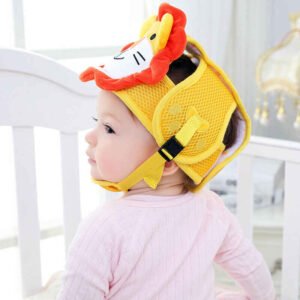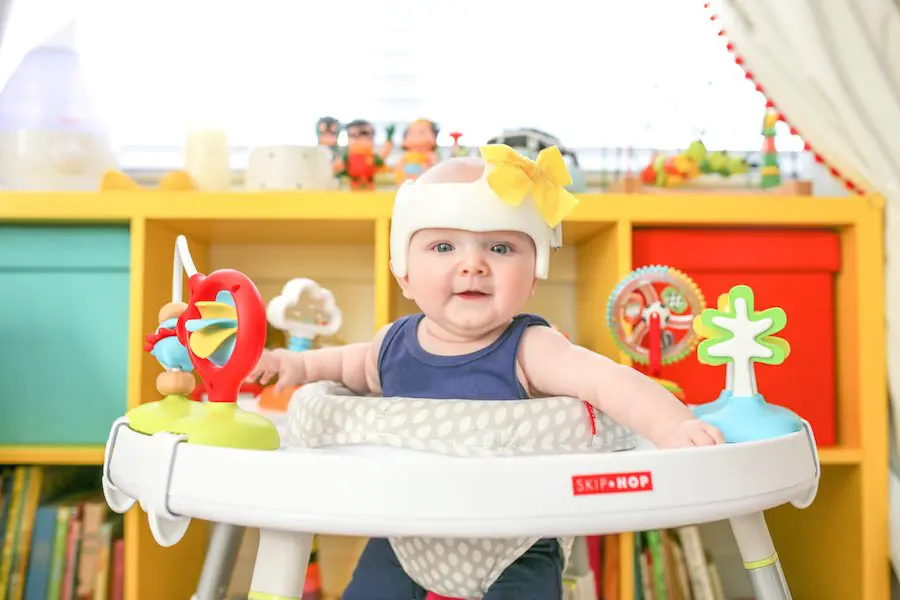Flat head syndrome in preschool is very common Preschool is the year for exploration, making friends, and learning the basics. But how does your child do that if they have flat-head syndrome also known as positional plagiocephaly?
This is something that happens over a long period if the baby’s head is positioned in one spot continuously on one side while sleeping.
How to Help Flat Head Babies and Toddlers in Daycare or Preschool
First things first make sure that your child is protected by wearing a DOC BAND which is a protective headgear that applies pressure to your child’s head to correct their head growth. Starting at the age of 4-6 months and seeing visible growth as little as 2 weeks.
The DOC band is a lifesaver for most babies and can be worn 23 hours a day and is corrected by clinicians throughout the entire process.
However, if your insurance can’t or won’t cover fees to afford a DOC BAND be sure to grab these cheap protective helmets for kids when sending them off to play.

Tummy Time
One of the best ways for babies and toddlers to get to know each other is through Tummy Time. While playing on the floor babies and toddlers build fine motor and gross motor skills while interacting with others.
Children with plagiocephaly need a lot of tummy time to refrain from laying on the floor on either side of their heads when playing games.
Baby Walker Toys
Baby Walker Toys are great for babies to learn how to walk and bounce around while talking to other friends in the group.
The benefit of utilizing a baby walker in preschool is that it builds muscle and hand-eye coordination when strolling. While in a baby walker, will help your child to help keep their head up when moving around the room.
Circle Time
At circle time while singing songs daycare teachers can hold babies and toddlers with the flat head syndrome in an upright position in their laps while singing nursery rhymes and doing activities.
Circle time is always imperative for a child’s growth and development and you wouldn’t want your child to miss out on this fun opportunity.
Flat Head Pillows
Utilizing a baby pillow for newborns it makes it easier for the baby or toddler to lay flat on their backs while playing without developing plagiocephaly.
Using these pillows in daycare or preschool is a great way to prevent flat heat syndrome in babies because it can be utilized for long periods and is breathable to your child’s needs.
Engaging Activities for Preschoolers with Flat Head Syndrome: Promoting Development and Comfort
Flat head syndrome, also known as positional plagiocephaly, is a condition that affects many infants, often due to prolonged time spent lying on their backs.
While prevention and treatment strategies are crucial, engaging preschoolers with flat head syndrome in activities tailored to their needs can be both beneficial and enjoyable.
These activities not only promote their overall development but also ensure their comfort and confidence in their abilities.
Firstly, activities that encourage gross motor skills are paramount for preschoolers with flat head syndrome.
Engaging in outdoor play such as running, jumping, and climbing on playground equipment not only stimulates physical development but also helps alleviate pressure on the affected area by varying head positions. Simple games like “Red Light,
Green Light” or “Simon Says” can incorporate movements that encourage children to look in different directions, thus reducing the likelihood of prolonged pressure on one part of the head. Additionally, activities like yoga or dance classes can promote balance, coordination, and body awareness while providing opportunities for diverse head movements.
Furthermore, sensory activities play a crucial role in the development of children with flat head syndrome. Sensory bins filled with materials like rice, beans, or sand offer opportunities for exploration through touch and manipulation, engaging children in sensory stimulation while allowing them to experiment with different head positions.
Water play activities, such as playing with water tables or splashing in shallow pools, not only provide sensory input but also encourage head movements in various directions.
Supporting Social Interaction and Communication in Preschoolers with Flat Head Syndrome
Incorporating different textures and materials into arts and crafts activities further enhances sensory experiences while promoting creativity and fine motor skills development.
Moreover, activities that foster social interaction are essential for the holistic development of preschoolers with flat head syndrome. Group games and cooperative activities encourage children to engage with their peers, fostering communication skills, empathy, and teamwork.
Circle time activities like storytelling, singing songs, or participating in group discussions provide opportunities for children to practice listening and speaking while participating in activities that do not require prolonged periods of lying down.
Additionally, collaborative art projects or dramatic play scenarios encourage imagination and creativity while promoting socialization in a comfortable and supportive environment.
Fostering cognitive development and language skills in preschoolers with flat head syndrome
In addition to physical and social activities, cognitive stimulation is vital for preschoolers with flat head syndrome.
Educational games and puzzles that require problem-solving, pattern recognition, and spatial reasoning not only stimulate cognitive development but also encourage children to explore different head positions while focusing on the task at hand.
Board games or card games adapted to accommodate their needs can also provide opportunities for cognitive engagement while promoting social interaction.
Furthermore, activities that involve sorting, categorizing, and matching objects help develop early math skills while encouraging children to move their heads in various directions.
Equally important are activities that promote language development and communication skills in preschoolers with flat head syndrome.
Reading books together, engaging in conversations, and singing nursery rhymes not only foster a love for language but also provide opportunities for children to practice different head movements while focusing on auditory stimuli.
Incorporating storytelling props or puppets into dramatic play activities can further enhance language development while sparking imagination and creativity.
Additionally, simple language games like “I Spy” or rhyming games offer fun ways to promote vocabulary expansion and phonological awareness.
Fostering Independence and Overall Well-being in Preschoolers with Flat Head Syndrome
Furthermore, activities that promote self-help skills and independence are crucial for preschoolers with flat head syndrome.
Encouraging children to participate in activities such as dressing themselves, feeding, or tidying up not only fosters independence but also provides opportunities to practice different head movements in various positions.
Simple cooking or baking activities adapted to their abilities allow children to explore different textures and sensory experiences while learning valuable life skills.
Additionally, activities that promote mindfulness and relaxation, such as guided meditation or gentle stretching exercises, can help alleviate any discomfort associated with the condition while promoting overall well-being.
In conclusion, engaging preschoolers with flat head syndrome in a variety of activities tailored to their needs is essential for promoting their overall development and well-being.
Activities that encourage gross motor skills, sensory exploration, social interaction, cognitive stimulation, language development, and self-help skills not only address specific areas of development but also ensure their comfort and confidence in their abilities.
By providing a supportive and inclusive environment where children can thrive, caregivers and educators play a crucial role in helping preschoolers with flat head syndrome reach their full potential.






